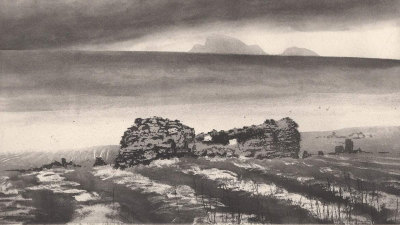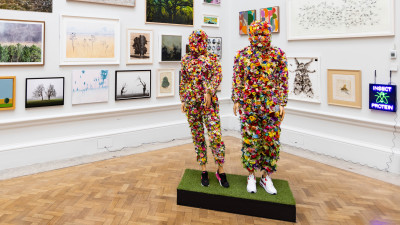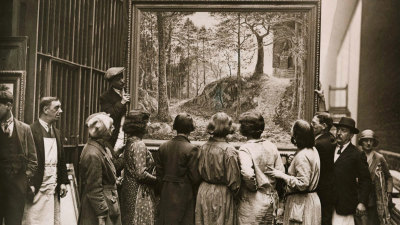Summer Exhibition 2012
Summer Exhibition 2012
By Rachel Campbell-Johnston
Published 23 May 2012
Now in its 244th year, the Summer Exhibition is the world’s biggest open submission show. Co-ordinator and painter Tess Jaray RA explains why she thinks small is beautiful.
-
The old grows outworn. The traditional starts to look fusty. So how can it once more be made to feel relevant and fresh? This is the problem that the Royal Academy’s Summer Exhibition must face.
This cultural beano has been a fixture of the calendar ever since the RA was founded back in 1768. At that time an art show was still a novelty in England and this densely packed, higgledy-piggledy parade was among the great spectacles of Georgian and Regency London. It was a glorious bear garden that every ambitious artist would have aspired to be part of and no gossiping socialite would have wanted to miss. It was the stage upon which the triumphs and the tragedies, the scandals and sensations, the celebrations and controversies of the British art world were played out.
-

Tess Jaray RA has chosen to hang the walls of the grand Gallery III with small-scale works to showcase emerging talent
Photo © Richard Dawson
-
But how can an annual ritual that has been re-enacted on more or less the same model for almost 250 years not risk turning into a tired old cliché? How can the Summer Exhibition be made to feel cutting-edge and contemporary? This is the challenge that the painter Tess Jaray RA faces.
Jaray has been appointed co-ordinator of this year’s Summer Exhibition. “I think that probably means something different every year,” she says. But basically, she sees herself as a sounding-board for the hanging committee, a team of fellow artists who, having worked together over the course of several months, will try to pull together something that matters out of the vast visual jumble of the world’s largest open submission exhibition.
-

Olu Shobowale, 'Chicken chair'.
© Olu Shobowale/Photo John Bodkin..
-
Jaray, elected a Royal Academician two years ago, has clearly been chucked straight in at the deep end. But when it comes to bringing new life to well trodden spaces she is an old hand. Born in 1937 in Vienna, she and her family came to England as part of the flood of Jewish refugees from the Nazis in 1938 and from then on she was brought up in the English countryside. Jaray studied first at Saint Martin’s and then at the Slade under Coldstream and Gombrich. But it was a scholarship trip to Italy in 1960 that she sees as her landmark moment. “It wasn’t the paintings that most impressed me,” she says. “I already knew about them. It was the architecture. It struck me with a tremendous force. I still haven’t got over it.”
The work that, in the ensuing decade, established her name was, she explains, “a reflection of the kind of emotion that I had experienced in those great architectural spaces”. Her painting is abstract: characterised by an obsessive focus on pattern and colour, on geometry and repetition. “It seems to be Jaray’s particular fate to sense the ways in which our history of decoration and patterning is embedded with elemental human experiences and impulses,” writes the critic Terry Pitts in his introduction to her forthcoming exhibition at the new Piper Gallery in London.
-

Dexter Dalwood, Stevie.
© 2012 Dexter Dalwood/Courtesy Gagosian Gallery.
-
By the mid-1980s, Jaray was beginning to work within architectural contexts and in 1992 she was given the commission for what she describes as “the most exciting thing I have ever done in my life”. She was asked to come up with a scheme for the precinct of Wakefield Cathedral: a dead space between the soaring ecclesiastical façade and a rank of shops. Jaray, working with the simple but dedicated perfectionism that characterises all her work, turned this abandoned space into a busy town square by laying down patterned brickwork and creating a sweeping flight of steps.
Understatement is, in a sense, Jaray’s trademark. Among her own contributions to this year’s Summer Exhibition will be two small paintings of squares. They are meditations on Malevich, the pioneering Modernist who first taught her that “much can be said with the most simple means”.
The question Jaray constantly asks herself as an artist is “How is it possible to cut out everything that is extraneous to what you want to say?” Now, she turns that question to the task of curating. When invited to hang a single gallery at the Summer Exhibition last year, she created a quietly cerebral haven. In contrast to Michael Sandle RA’s far more ebullient gallery it was like War and Peace, remarked the sculptor Paul de Monchaux.
-

Onya McCausland, Blue Blue, 2012.
Courtesy of Onya McCausland/Photo John Bodkin..
-
Something of this calmness will infiltrate the vast and various Summer Exhibition this year, says Jaray, sitting at a vast paper-strewn desk in her Camden studio, alternating cigarettes with nicotine lozenges and cups of black coffee and fielding periodic phone calls – “Yes, of course we would love something from Kiefer”. She points out a row of three rooms (Galleries V, VI and VII) on a densely annotated plan of the galleries. “These will be the most demanding rooms,” she says. “They will form a sort of intellectual spine to the exhibition as, blurring the edges between painting, sculpture and architecture, they invite spectators to ponder what artists and architects have in common, what attitudes they share. They will contain works by such artists as John Carter RA, a sculptor known for his mathematically based ‘wall objects’ and Nigel Hall RA, whose abstract constructions reflect and explore the sites in which they are placed. Then there is Rana Begum who, inspired by both Islamic art and contemporary architecture, makes simple, reductive, but immaculately finished and brilliantly coloured works that capture the poetry of the city and its structures.”
-

David Batchelor, 28.03.11.
Courtesy of the artist..
-
Jaray wants the focus to be emphatically on quality. “There are lots of open-submission exhibitions,” she explains, “but the RA summer show is the most important. We want to attract a broader application from younger, emerging and newly successful artists, to make this show reflect what is exciting about art across the country. There are so many artists working in Britain now (she says the number of artists working in Hackney today is the same as the total population of Renaissance Florence) and someone has to take responsibility for them. The RA can do that with the Summer Exhibition.”
Works of a more modest size have been actively selected. “There is an element of anti-gigantism,” Jaray declares. “Museums are full of massive works, but it can be easier to make a large work than a smaller one. To make a successful painting on a modest scale needs an enormous amount of concentrated energy,” she says – and she knows: her own works, as small as they are scrupulous, are models of painstaking perfectionism.
In a major shift away from tradition, the largest gallery is devoted to the sort of small pieces that are normally crammed into an out-of-the-way corner. Here will be a diverse mix of paintings, drawings, collages and three-dimensional pieces. It will include works from Turner Prize winner Martin Creed, the playful minimalist who created the notorious room with lights going on and off, Andrea McLean whose dense surfaces teeming with birds, beasts, flowers and trees, double up as a delicately detailed diary of her experiences, Neil Jeffries’s wall-based sculpture, David Batchelor’s jewel bright minimalist painting. All works will be hung in a wave that undulates round the walls and will hopefully, Jaray explains, make them more accessible.
Jaray taught at the Slade from 1968 to 1999, nurturing a great enthusiasm for new and upcoming talent that translates well for curating the Summer show. There is, for example, Olu Shobowale who recycles waste materials – including animal bones – into structures that reference everyday objects.
-

Tess Jaray RA, After Malevich.
© Tess Jaray/Photo John Bodkin.
-
“We have particularly encouraged a greater international spread,” she says. She has invited artists from 30 or so nations, including Afghanistan. “I felt that the RA should put out a hand and say, I know that you are working and we admire you for working in your war-torn country,” says Jaray.
The walls of the octagonal gallery in the show are painted a brilliant red. “It’s a nod in the direction of Matisse’s Red Studio,” says Jaray. “I have yet to see a work that doesn’t go with red.” Another gallery is entirely devoted to the work of Jayne Parker, a film-maker who is fascinated by the ways in which music is expressed, in how the structure of film can reflect the structures of sound.
-

Tess Jaray RA, After Malevich.
© Tess Jaray/Photo John Bodkin..
-
“Parker’s films concentrate on various visual aspects of performance art,” explains Jaray, “on the quality of the performer’s concentration, the movement of the body, the touch of the hands on the instrument. She asks us to wonder ‘Where is music expressed? Where is the "site of music,” articulating the experience of hearing music visually.’ This takes us inside the performance, in order to create something that touches our hearts, to really feel what we hear. Images intercut with video of the performance symbolically or metaphorically lead us to reflect on the sound and the way it can affect us, capturing the mystery of the felt experience,“ Jaray suggests. "Through Parker’s work we come to understand more of the complexity of what we are listening to and how it affects us.”
The final gallery in the Summer Exhibition, so often treated as something of an afterthought, will this year become a grand finale: a firework display of visual vitality. Artists at the height of their achievement – Mimmo Paladino Hon RA, Tracey Emin RA, Dexter Dalwood, and Gary Hume RA among them – will present works that rejoice in the world, that speak of the pleasure and happiness of painting, says Jaray. “This gallery will capture the breadth and vision of art at the moment.”
She is clearly not worried that the Summer show will look fusty. “Art is continually on the move. It never rests. It’s always changing.”
And that’s what lends it freshness and relevance and life.
-
Summer Exhibition, Main Galleries, 4 June – 12 August 2012. Sponsored by Insight Investment
‘Painting: Mysteries and Confessions’ Tess Jaray’s collection of writings is republished by the RA.
Rachel Campbell-Johnston is art critic for ‘The Times’.










